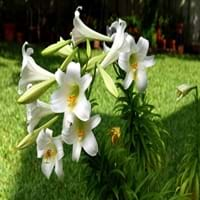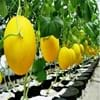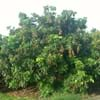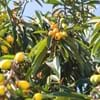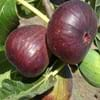Life Span
Annual or Biennial
Perennial
Type
Fruit
Bulb or Corm or Tuber
Types
Earlibrew, Honey King, Moonshine, Brilliance,Honey Chow
Madonna lily, Turk's cap lily
Number of Varieties
Not Available
Habitat
Semi arid regions
Coastal Regions, Temperate Regions, Tropical regions
USDA Hardiness Zone
Not Available
6-9
Sunset Zone
2a, 2b, 3a, 3b, 4, 5, 6, 7, 8, 9, 10, 11, 12, 13, 14, 15, 16, 17, 18, 19, 20, 21, 22, 23, 24
21,22
Habit
Vining/Climbing
Upright/Erect
Flower Color
Yellow
White, Light Yellow, Ivory
Flower Color Modifier
Bicolor
Bicolor
Fruit Color
White, Yellow, Salmon
Green, Brown
Leaf Color in Spring
Green
Green, Dark Green
Leaf Color in Summer
Dark Green
Light Green
Leaf Color in Fall
Dark Green
Several shades of Green
Leaf Color in Winter
Light Green
Light Green
Leaf Shape
Heart-shaped
Oval
Plant Season
Summer, Fall
Summer
Sunlight
Full Sun
Full Sun, Partial Sun, Partial shade
Type of Soil
Loam
Loam, Sand
The pH of Soil
Neutral
Neutral, Alkaline
Soil Drainage
Well drained
Well drained
Bloom Time
Indeterminate
Summer
Tolerances
Drought
Heat Tolerance, Salt, Shade areas
Where to Plant?
Container, Ground
Container, Ground, Pot
How to Plant?
Seedlings
Divison, From bulbs, Seedlings
Plant Maintenance
Medium
Medium
Watering Requirements
Reduce watering once fruit are growing, Requires a lot of watering, Requires consistently moist soil
Average Water Needs, Do Not over Water, Never Over-water, Requires regular watering
In Summer
Lots of watering
Lots of watering
In Spring
Moderate
Ample Water
In Winter
Average Water
Average Water
Soil pH
Neutral
Neutral, Alkaline
Soil Type
Loam
Loam, Sand
Soil Drainage Capacity
Well drained
Well drained
Sun Exposure
Full Sun
Full Sun, Partial Sun, Partial shade
Pruning
Remove damaged leaves, Remove dead branches, Remove dead leaves
Prune in winter, Remove dead branches, Remove dead leaves
Fertilizers
All-Purpose Liquid Fertilizer
All-Purpose Liquid Fertilizer, Water soluble fertilizers
Pests and Diseases
Anthracnose, Aphids, Bacterial fruit blotch, Cucumber beetles, Downy mildew, Southern Bacterial Wilt, Spider mites
Beetles, Red blotch, Sawfly Larvae, Slugs, Snails
Plant Tolerance
Drought
Heat Tolerance, Salt, Shade areas
Flower Petal Number
Single
Single
Foliage Texture
Coarse
Medium
Foliage Sheen
Matte
Glossy
Attracts
Not Available
Beetles, Flying insects
Allergy
breathing problems, Cough, cramps, Diarrhea, Itchy eyes, Mouth itching, Nasal Congestion, Throat itching, wheezing
Kidney Disease, Toxic
Aesthetic Uses
Not Used For Aesthetic Purpose
Beautification, Landscape Designing, Showy Purposes
Beauty Benefits
Not Available
Good for skin, Good for skin and hair, Improve hair condition, Improve skin condition
Environmental Uses
Air purification
Air purification, Food for insects, Prevent Soil Erosion
Medicinal Uses
Potassium, Vitamin C
No Medicinal Use
Part of Plant Used
Fruits, Leaves, Root, Seeds
Flowers, Leaves
Other Uses
Added to salads, Used in tea, wine and sweet dishes, Used to flavour soups
Decoration Purposes, Showy Purposes, Traditional medicine, Used as Ornamental plant
Used As Indoor Plant
No
Yes
Used As Outdoor Plant
Yes
Yes
Garden Design
Edible, Fruit / Fruit Tree, Herb / Vegetable, Vine
Cutflower, Mixed Border
Botanical Name
CUCUMIS melo 'Honey I Dew'
LILIUM longiflorum
Common Name
Honey I Dew Honeydew, Honeydew
Easter Lily
In Hindi
खरबूज़ा [kharabooza]
ईस्टर लिली
In German
Honigtau
Osterlilie
In French
Miellat
lis de Pâques
In Spanish
Gotas de miel
Lily Pascua
In Greek
πεπόνι μελιτώματος [pepóni melitómatos]
Πάσχα Lily
In Portuguese
melão de Honeydew
Lily Páscoa
In Polish
melon spadzi
Easter Lily
Phylum
Magnoliophyta
Embryophyta
Class
Magnoliopsida
Liliopsida
Order
Cucurbitales
Liliales
Family
Cucurbitaceae
Liliaceae
Clade
Not Available
Angiosperms, Monocots
Tribe
Not Available
Lilieae
Subfamily
Not Available
Lilioideae
Number of Species
Not Available
Not Available
Importance of Honeydew and Easter Lily
Want to have the most appropriate plant for your garden? You might want to know the importance of Honeydew and Easter Lily. Basically, these two plants vary in many aspects. Compare Honeydew and Easter Lily as they differ in many characteristics such as their life, care, benefits, facts, etc. Every gardener must at least have the slightest clue about the plants he wants to plant in his garden. Compare their benefits, which differ in many ways like facts and uses. The medicinal use of Honeydew is Potassium and Vitamin C whereas of Easter Lily is No Medicinal Use. Honeydew has beauty benefits as follows: Not Available while Easter Lily has beauty benefits as follows: Not Available.
Compare Facts of Honeydew vs Easter Lily
How to choose the best garden plant for your garden depending upon its facts? Here garden plant comparison will help you to solve this query. Compare the facts of Honeydew vs Easter Lily and know which one to choose. As garden plants have benefits and other uses, allergy is also a major drawback of plants for some people. Allergic reactions of Honeydew are breathing problems, Cough, cramps, Diarrhea, Itchy eyes, Mouth itching, Nasal Congestion, Throat itching and wheezing whereas of Easter Lily have Kidney Disease and Toxic respectively. Having a fruit bearing plant in your garden can be a plus point of your garden. Honeydew has showy fruits and Easter Lily has no showy fruits. Also Honeydew is not flowering and Easter Lily is not flowering . You can compare Honeydew and Easter Lily facts and facts of other plants too.

